Firstly, we are pleased to report that our generic wireless mouse worked to its usual standard in the MSI Z170 UEFI. We’ve found the wireless mouse to be troubling with UEFI support in the past, so when it functions correctly in the interface, that is usually a good sign for overall mouse support.
Entry for MSI's new Click BIOS 5 interface is the task of a new page that features the system's core information.
This is an approach that Asus has successfully used with its UEFI and it is something that I like as it feeds core information to less-experienced users without flooding them with confusing and in-depth system information.
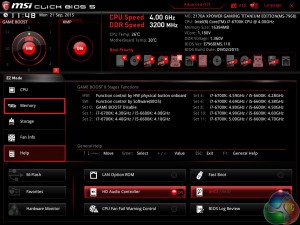
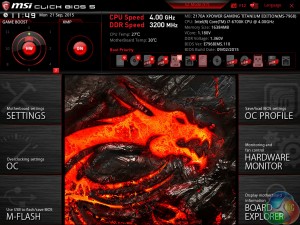
Scrolling down the entry page highlights the overclocking presets that deploys via the eight-point onboard OC dial. I like seeing multiple presets being supplied for i5 and i7 users as it gives greater choice to the system operator.
Pressing F7 takes users into the UEFI's advanced section where the core values relating to voltages, clock speeds, and other features can be controlled.
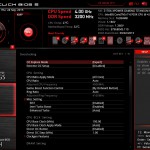
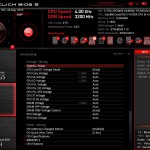
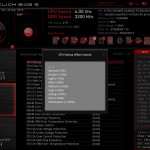
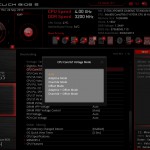
MSI provides a good range of adjustable settings for overclocking users. There is a selector that allows a normal or extreme mode to be applied, based upon your overclocking preferences.
Plenty of options are provided for the CPU VCore operation. MSI also includes a number of VDroop options, however many of these settings use percentage values that most users will not understand and there is no explanation in MSI's info box. I would prefer the approach that competing vendors such as ASRock take by using a graph to highlight what each of its load-line calibration settings does.
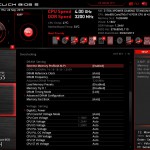
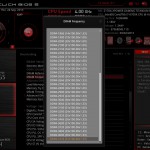
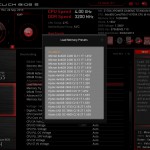
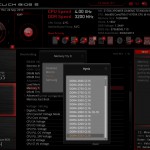
Plenty of adjustments can be made to system memory. MSI includes a divider up to 31x which allows for a frequency of 4133MHz using a 100MHz BCLK. The granularity of the memory dividers will appeal to overclockers wanting to fine tune their system precisely.
Memory profiles presets are also supplied by MSI, with a number of configurations provided for use with Hynix, Samsung, and Micron DDR4.
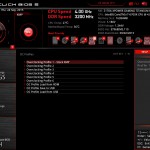
Up to six settings profiles can be named and saved as well as transferred via a USB drive.
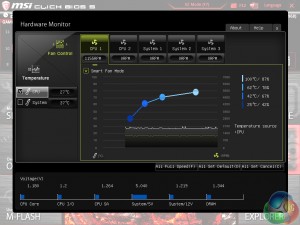
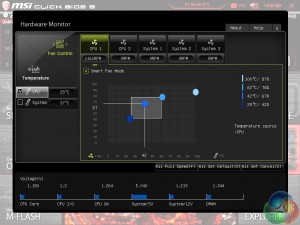
MSI's fan control method uses a 4-pin fan speed percentage against temperature curve to control the CPU and system fans. There is also the option to disable manual fan speed control with such refinement.
While MSI's manual control method is good and undoubtedly superior to Gigabyte's solution, there are no ‘silent‘ and ‘standard‘ fan speed presets that we see from the likes of Asus and ASRock.
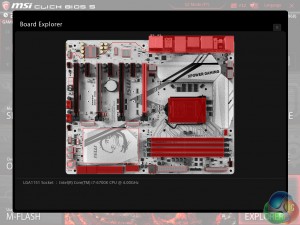
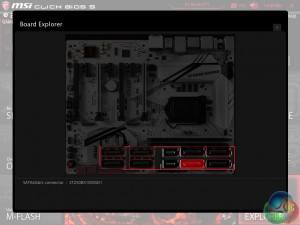
MSI's Board Explorer is a useful tool that I like seeing provided. It is particularly helpful when troubleshooting – for example a faulty stick of RAM can be identified as missing through the tool and one can check that all storage drives are connected to the most appropriate SATA ports without removing the chassis side panel.
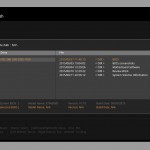
I am glad to report that MSI has finally updated the M-Flash utility by giving it the ability to search through a drive's directories and folders. The tool works without issue.
UEFI Comments
MSI has made a number of notable improvements for its Click BIOS 5 implementation found on Z170 motherboards. The addition of a simplified UEFI entry screen is positive and the sheer quantity of overclocking presets not only for the CPU, but also the memory, is welcomed. M-Flash now works in the way that competing vendors' solutions also do. MSI's strong, if not market-leading, fan control methods have also been retained.
While I still think that Asus has the best UEFI implementation on the market, MSI has conjured up a solution that competes with the market-leading competitor in many aspects and actually beats it in some (Board Explorer). The UEFI's strengths are widespread and its areas for improvement are relatively minor.
 KitGuru KitGuru.net – Tech News | Hardware News | Hardware Reviews | IOS | Mobile | Gaming | Graphics Cards
KitGuru KitGuru.net – Tech News | Hardware News | Hardware Reviews | IOS | Mobile | Gaming | Graphics Cards


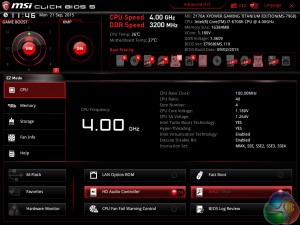

Allow me to show ~you a genuine way to earn a lot of extra money by finishing basic tasks from your house for few short hours a day — See more info by visiting >MY*&___(DISQUS)*%___ID)
I think you should do some reading before using harsh terms such as “stupid advertising”, perhaps you might even learn something new 😉
https://en.wikipedia.org/wiki/USB#USB_3.1
” The USB 3.1 standard increases the data signaling rate to 10 Gbit/s in the USB 3.1 Gen2 mode, double that of USB 3.0 (referred to as USB 3.1 Gen1)”
The information in that article, the referenced technical documents for which I have examined many times over the past year, says what I have said in the article. ‘USB 3.1 Gen 2’ is 10Gbps. USB 3.0 is 5Gbps and is sometimes referred to as ‘USB 3.1 Gen 1’ (by many vendors, not just MSI, as I clearly pointed out in the article).
5Gbps USB had always been referred to as USB 3.0 (pretty much universally, as far as I can tell) before USB 3.1 entered the consumer limelight. Now that USB 3.1 ports at up to 10Gbps are available, marketing teams are quickly changing the naming structures of their 5Gbps USB 3.0 ports. Even Intel refers to the 5Gbps ports as USB 3.0 connections in their very own chipset diagrams.
I fail to see what there is to learn from the Wikipedia page that I hadn’t already written in the article.
Luke
Sadly, you fail to see quite a lot.
Please expand as I want to make sure that the information is correct and clear.
I wrote what I wrote as there is currently a lot of confusion surrounding the USB interface due to its new forms and speeds. Many consumers do not realise that USB 3.1 *Gen 1* is just another name for the 5Gbps USB 3.0 connection and therefore may make an uninformed purchasing decision thinking that it is actually the 10Gbps USB 3.1 *Gen 2* port being referred to.
Thanks,
Luke
No, what you wrote was “stupid advertising”, implying that it’s fake and wrong, when in fact you were wrong and did not do your homework.
So, in fact, it’s not stupid advertising at all and it’s just the way that the USB Implementers Forum now ALSO refers to the USB 3.0 interface, making it quite official and NOT stupid advertising at all.
The only confusing things are in fact those you wrote and you seem to be the only one confused, but what’s even worse is that you do not willing to admit it and keep thinking you are not wrong.
Anyway, believe whatever you wish and misinform you readers any way you like or can.
audio 115bB… what’s it??
OK we’ll just have to agree to disagree. Intel sells the chipset with USB 3.0 ports (no reference to USB 3.1 Gen 1 – which is the same as USB 3.0 but a different name, as I clearly wrote in the article). If Intel, the chipset provider, sells them as USB 3.0 ports then there is very little reason to change that naming scheme and advertising/marketing would be one of the few reasons to do so. So the word ‘stupid’ in this case points out how there is no need to change the naming scheme of ports that derive from Intel’s Z170 chipset. The word ‘stupid’ doesn’t always need to imply ‘fake or wrong’ as you imply. Those two words are not fact anyway – as is clear by now, they are debatable and the information supplied afterwards is factually correct.
You keep referring to the information as ‘wrong’ when it isn’t. If you read the rest of the sentence and paragraph instead of focussing on two (clearly debatable) words out of over 6000 in the article then you will see what is written is correct, both in terms of naming and speeds. Is USB 3.1 Gen 2 rated at 10Gbps, as written? Yes. Is USB 3.1 Gen 1 the same as USB 3.0 and rated at 5Gbps, as written? Yes. Both of those pieces of information are correct, and not ‘wrong’ as you refer to them.
Anyway, this debate is going nowhere. I have pointed out to readers who know less about the new USB standards that USB 3.1 Gen 1 ports are the same as USB 3.0 5Gbps ports, not the newer USB 3.1 Gen 2 10Gbps ports. It’s clear and there is absolutely no misinformation so now readers can understand how to compare the number of USB 3.1 Gen 1 ports on this board against the number of USB 3.0 ports on other vendors’ boards.
The audio system is based around the Realtek ALC 1150 codec.
Why not dB? Box had the wrong, this is false advertising? Quality is very bad.
MSI’s Audio Boost 3 system uses the Realtek ALC 1150 audio codec which is rated at a SNR of 115dB.
I just have to say… Luke is definitely right. I’m not a member on this site, but I just had to link my google+ so that I could comment on this.
I was hoping to get some feedback from people who bought this board. Instead it’s the standard nerd-fight-fest I should have expected. How sad. Anyway, this is a cool and unique looking motherboard with tons of features that I will never possibly need. I only wish it was $100 less